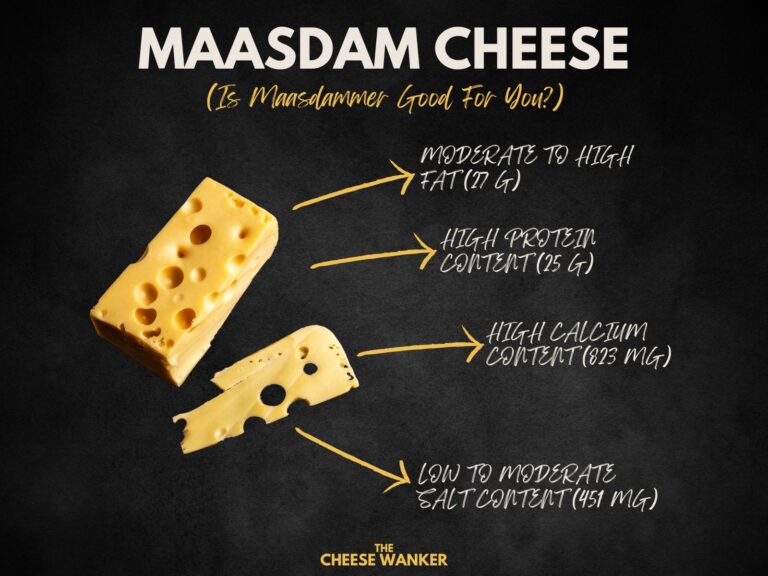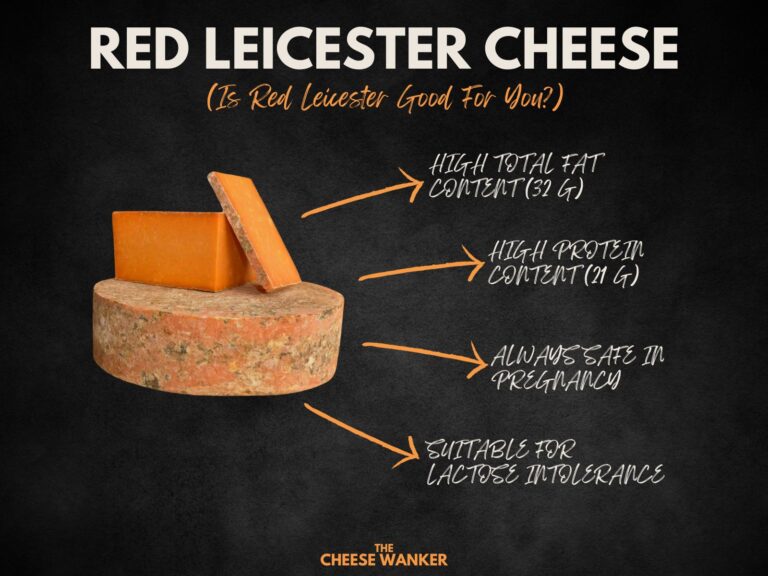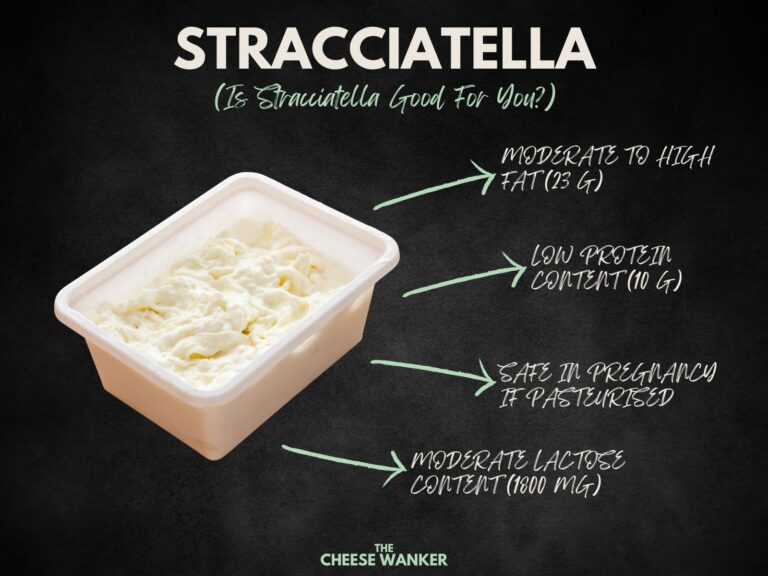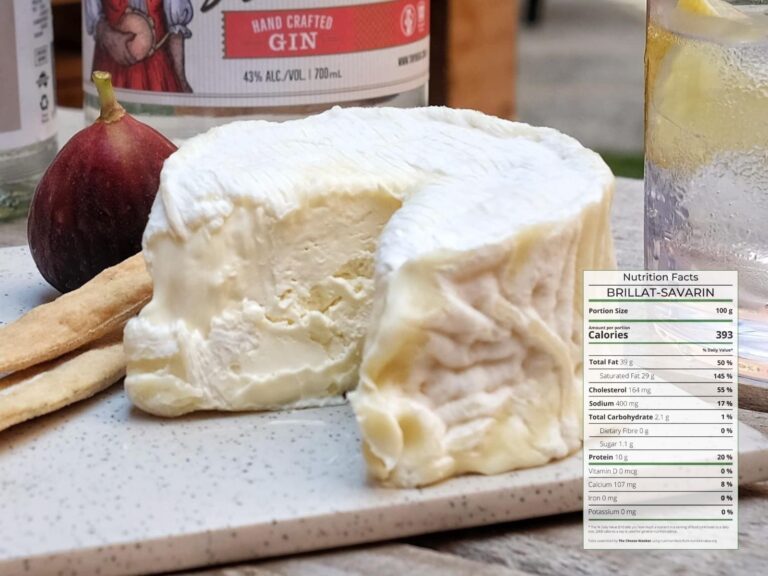Brie cheese, a soft and creamy delight hailing from France, has become a staple on cheese platters around the world. In this article, we delve into the nutrition facts of Brie, examining its macronutrient levels, salt content and its abundance in vitamins and minerals. Additionally, we explore considerations for specific demographics, such as pregnant women and those with lactose intolerance.
SEE ALSO: Nutrition facts for popular world cheeses in The Cheese Wanker’s index →
What is Brie cheese?
Brie finds its origins in the French region of Île-de-France and is renowned for its smooth texture, earthy aroma and distinctive white, bloomy rind.
Traditionally, French artisans crafted this soft cheese from raw cow’s milk but there are many modern pasteurised versions. After production, this cheese undergoes a ripening process, resulting in its characteristic creamy centre.
When serving, it is advisable to bring Brie to room temperature, enhancing its organoleptic properties and allowing its full flavour profile to unfold.
While there is no doubting the popularity of this cheese, is Brie actually good for your health? Read on to find out.
Nutrition fact sheet
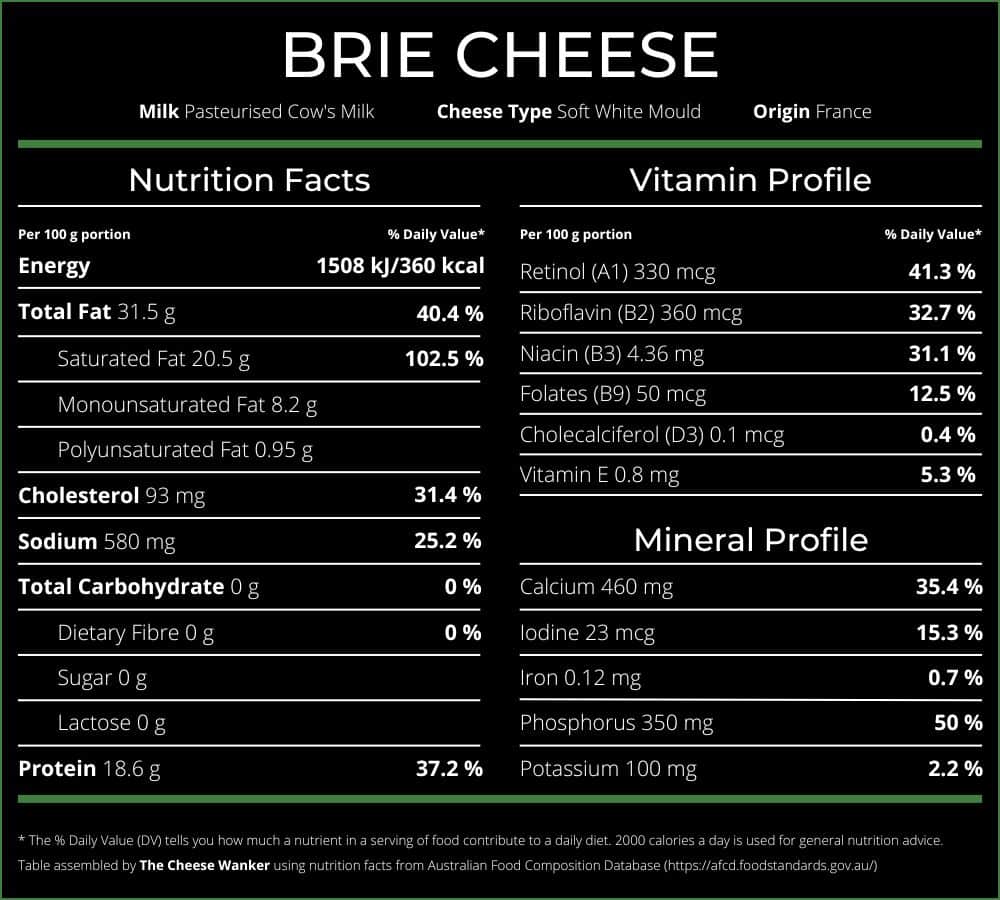
Nutritional review for Brie
Eating healthy plays a pivotal role in maintaining overall well-being and preventing chronic diseases. A balanced and nutritious diet provides our bodies with essential vitamins, minerals, and macronutrients, fuelling optimal physical and cognitive function.
With this in mind, let’s have a look at some of the key nutrition facts for Brie.
Sample cheeses used
The majority of nutrient data were derived from a composite of 5 samples of Australian Brie (Tasmanian Heritage, King Island, Australian Gold, South Cape and Bega) and 3 samples of French Brie (Mon Père, Fromage de Meaux and Président) purchased in Melbourne, Australia.
Calorie count
The samples of Brie analysed by FSANZ contained on average 360 calories per 100 g sample.
While calorie count is an essential indicator of energy intake, it is not the sole determinant of a food’s healthiness. Factors such as the source of calories, nutrient density, and overall dietary context play crucial roles in assessing the nutritional value of a food item.
Fat content
Brie cheese boasts a significant fat content (31.5 g), mainly comprising saturated fats (20.5 g). These fats, though often vilified, are a diverse group, and not all have the same impact on health.
Of course, moderation is key, as excessive saturated fat intake has been linked to cardiovascular issues.
You can learn more about the different types of fat in cheese and which cheeses have the lowest fat content here.
Protein content
Despite a lower protein content (18.6 g) compared to some aged cheeses, Brie remains a commendable source of protein. The protein in Brie includes various amino acids essential for bodily functions, highlighting the importance of protein in a balanced diet.
Want to find out which cheeses have the highest protein content? Click here for our blog post covering cheeses with the highest protein content.
Cholesterol content
Dietary cholesterol is a contentious topic. While Brie contains cholesterol (93 mg), the current scientific consensus suggests that dietary cholesterol has a limited impact on blood cholesterol levels for most individuals.
As with many aspects of nutrition, moderation is advised.
You can learn more about the impact of dietary cholesterol on blood cholesterol levels in our dedicated post here.
Salt content
Brie’s moderate to high salt content (580 mg) contributes to its savoury flavour profile.
Excessive salt intake is linked to health concerns, particularly for individuals with hypertension. Hence, it is crucial to monitor overall salt consumption for better cardiovascular health.
You can read more about why salt is important in cheesemaking in our comprehensive post here.
Calcium content
While lower than some aged cheeses, Brie remains a notable source of calcium (460 mg), vital for bone health, blood clotting and nerve function.
You can read more about this important mineral and find out which types of cheeses have the highest calcium content in our post here.
Other vitamins & minerals
Brie’s nutrient profile extends beyond the macronutrients, featuring an abundance of vitamins such as retinol, riboflavin, niacin and folates. And also, essential minerals like iodine and phosphorus.
Safety in pregnancy
Despite being made with pasteurised milk, commercial Brie is not recommended during pregnancy due to its high moisture content, which increases the risk of Listeria contamination.
Therefore, expectant mothers are advised to opt for safer cheese alternatives.
Of course, if you’re unsure of what you can eat during pregnancy, you should consult your healthcare professional to get a personalised plan. You can read more about which cheeses you can eat when you’re pregnant by clicking here.
Lactose intolerance
Surprisingly, Brie is low in lactose, making it a potentially suitable option for those with lactose intolerance.
However, individual tolerance varies, and caution is advisable.
Conclusion
Brie cheese, with its rich and indulgent flavour, contributes to a diverse and enjoyable culinary experience. Understanding its nutritional content empowers consumers to make informed dietary choices.
While moderation is key, Brie can be a part of a balanced diet, providing an array of nutrients that contribute to overall well-being.
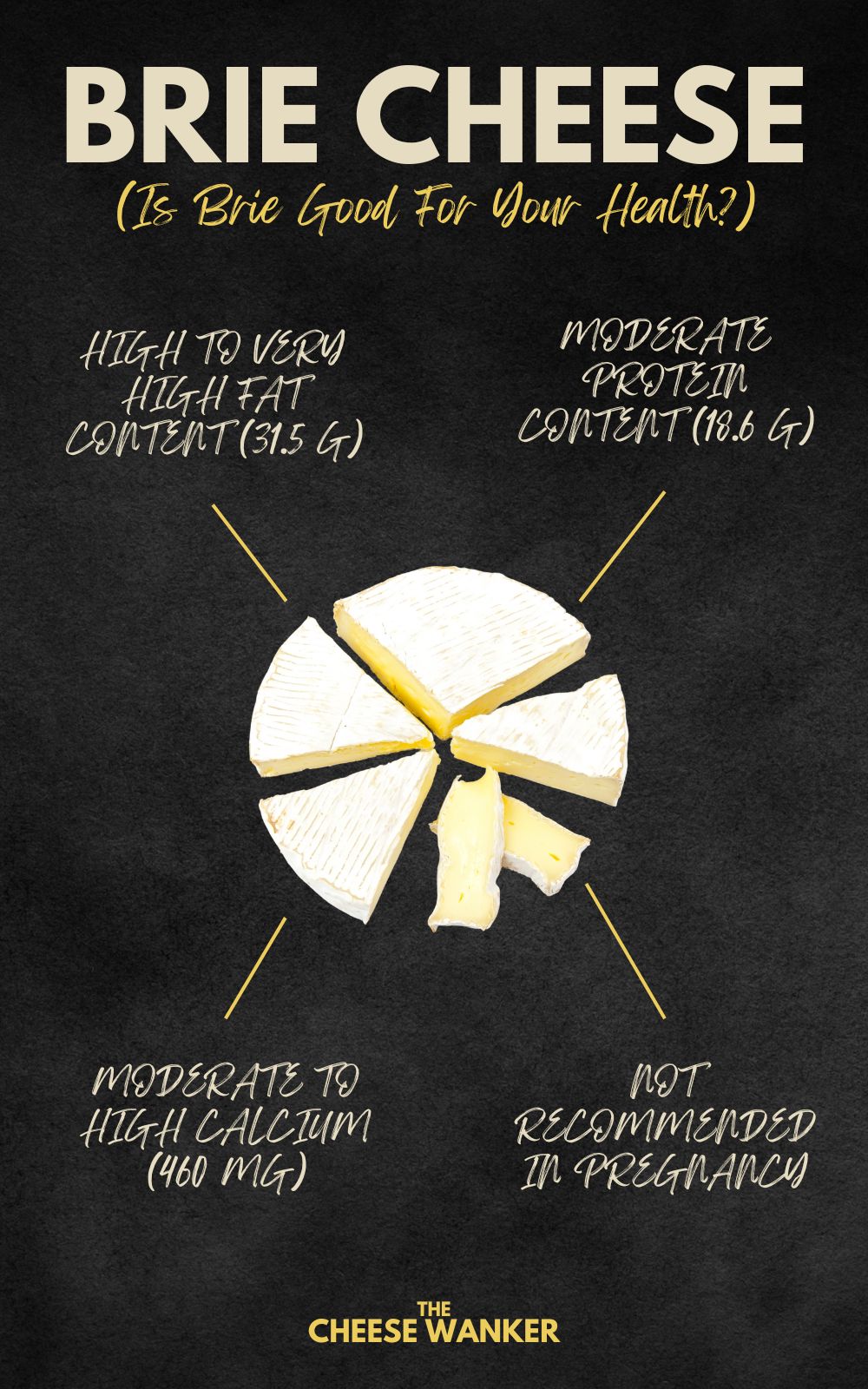
References
Overall nutritional content
The nutritional content of cheese in our table comes from the USDA Food Data Central Repository, the Australian Food Composition Database and cheese manufacturers. We realise that there can be variations between different brands and producers. Hence, the numbers we have used are averages.
Fat content
Our fat RDI data comes from Cleveland Clinic’s Healthy Fat Intake resource.
Type of fat in cheese as per Harvard T.H. Chan’s The Nutrition Source.
Protein content
Our protein RDI data comes from Harvard Medical School’s Harvard Health Publishing.
Cholesterol content
Is There a Correlation between Dietary and Blood Cholesterol? Evidence from Epidemiological Data and Clinical Interventions? – Maria Luz Fernandez and Ana Gabriela Murillo
Saturated fat, carbohydrate, and cardiovascular disease – Patty W Siri-Tarino, Qi Sun, Frank B Hu and Ronald M Krauss
Effect of cheese consumption on blood lipids: a systematic review and meta-analysis of randomized controlled trials – Janette de Goede, Johanna M Geleijnse, Eric L Ding, Sabita S Soedamah-Muthu
Safety in pregnancy
All the advice relating to what cheeses you can eat during pregnancy in this article is based on the recommendations by health authorities in Australia, the UK and the USA. If you are unsure about what you can or cannot eat, please consult your doctor.
Australia – FSANZ, United Kingdom – NHS and United Sates of America – FDA
Lactose content
Lactose residual content in PDO cheeses
Detection of lactose in products with low lactose content
The analysis of lactose in milk and cheese products by HPLC
Food Standards ANZ Food Composition Database
Lactose & Galactose content of cheese
